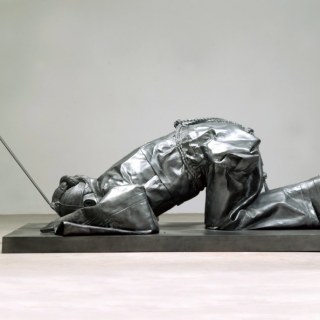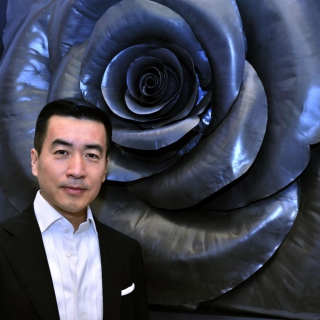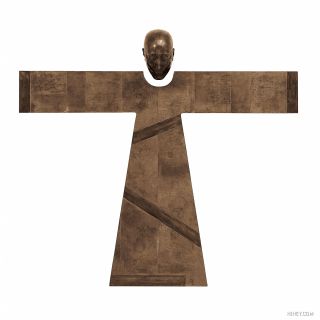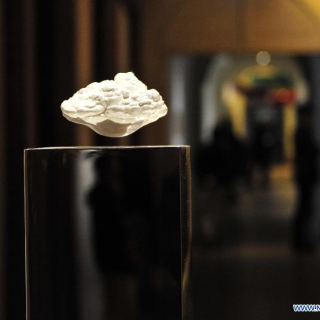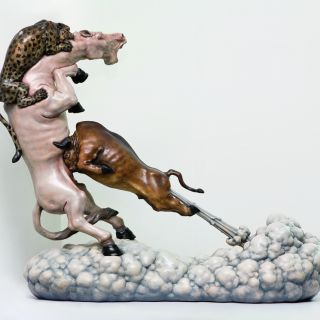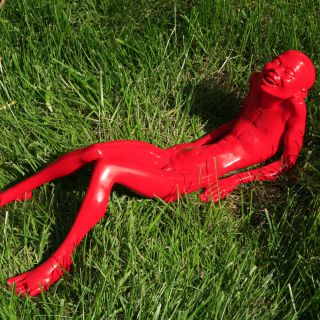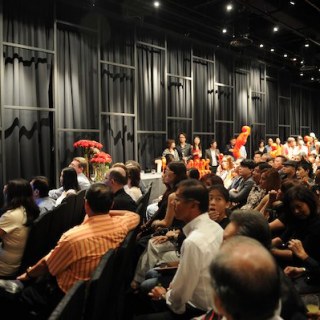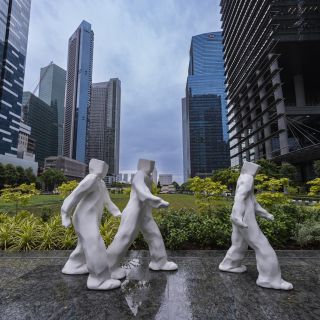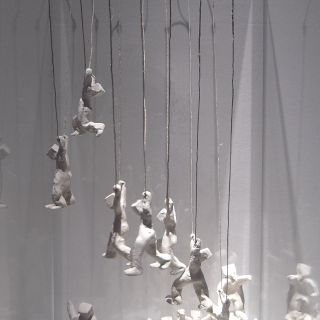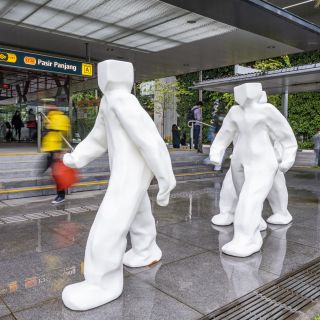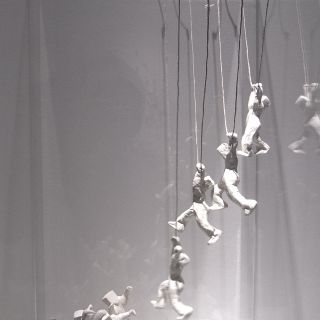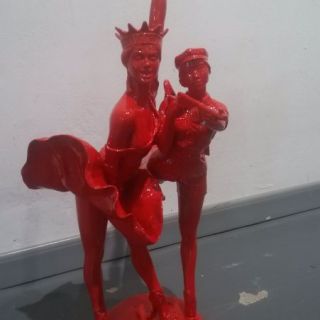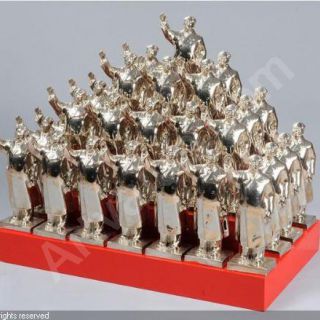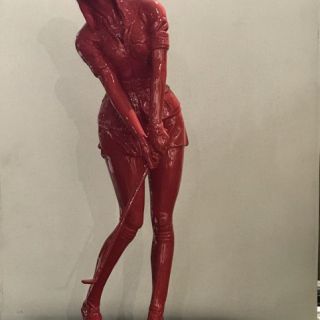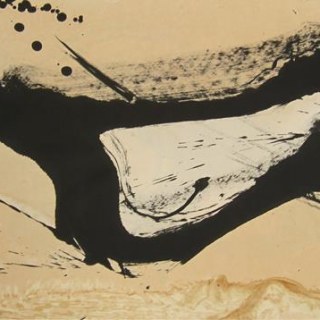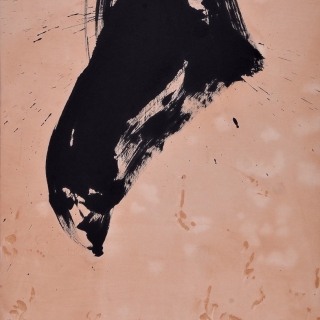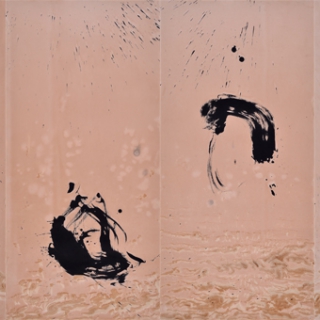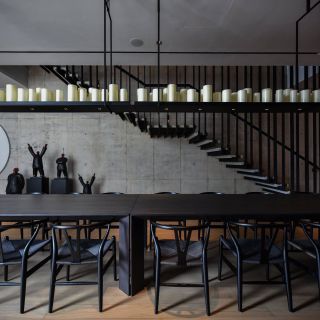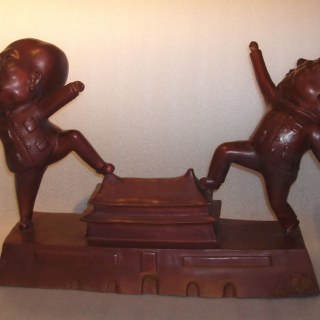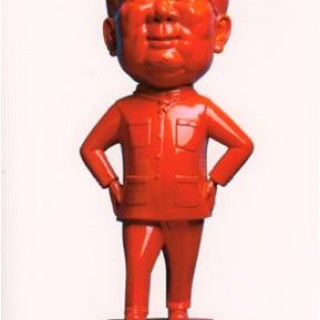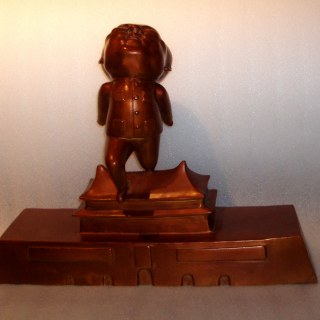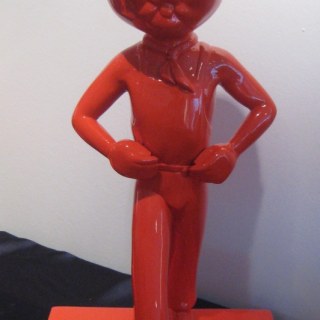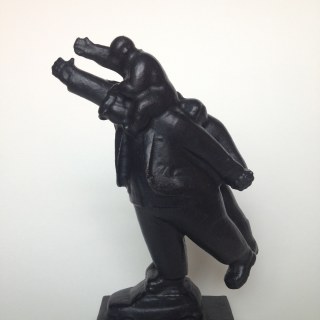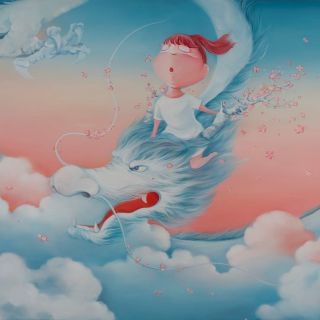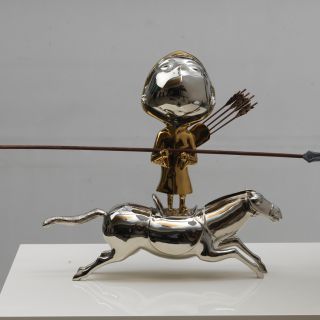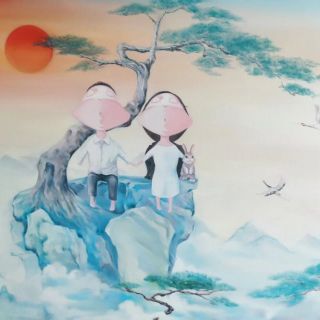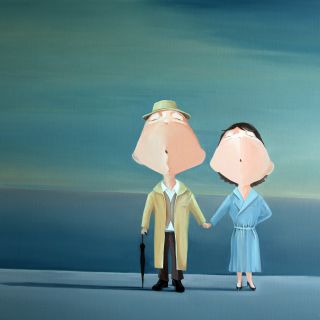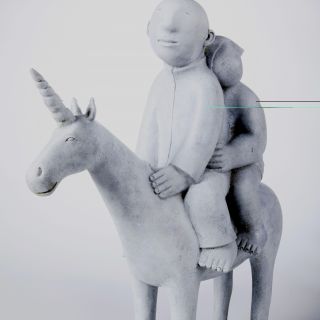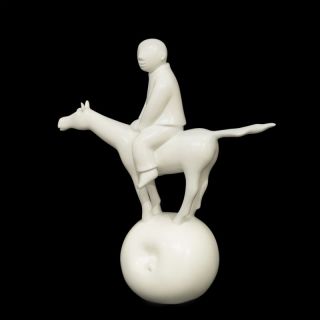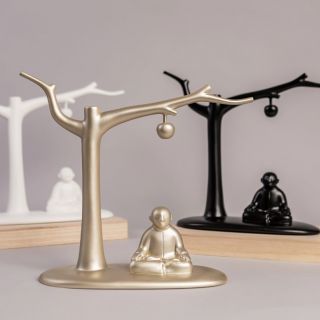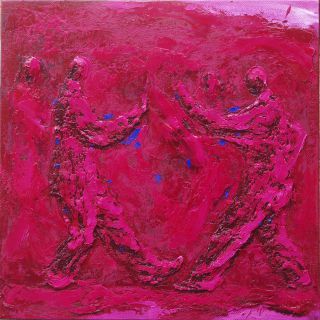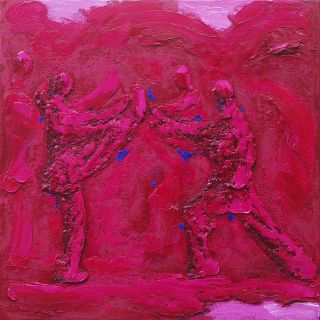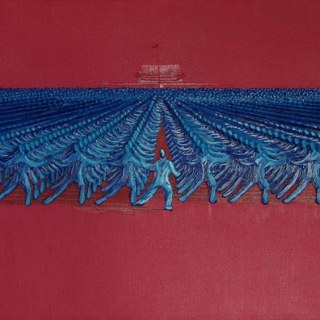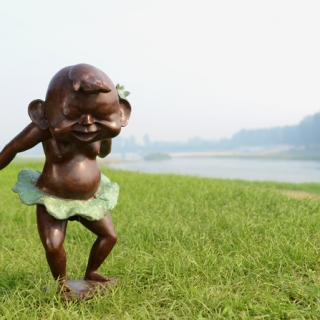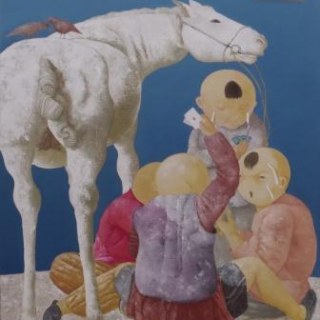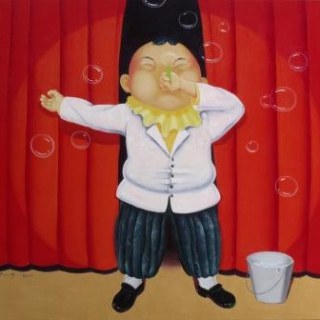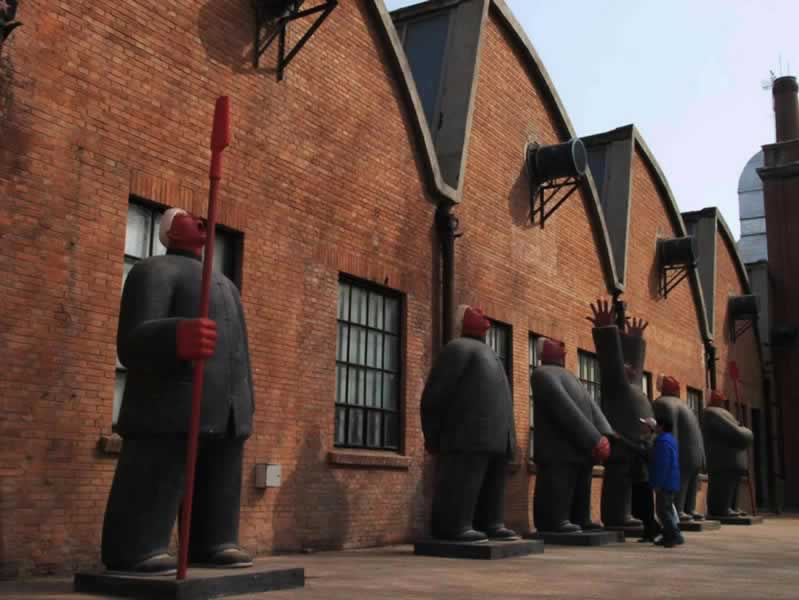
Born in 1970 in Shaanxi, China, Liu Ruo Wang creates art that touches on an immense array of cultural elements, while remaining firmly rooted in a personal journey through time and struggle. Turning a childhood of myth and folklore into a representation of the Chinese spirit, the artist chooses to glorify the ordinary man by presenting him as a an emblem of solidarity, tying together bands of soldiers in distinctly Eastern colour, texture and form. A coalescence of nostalgia and tribute, the artist immortalizes his roots, subtly making reference to the history and significance that form the rich heritage behind the industrialized modernity of his people. Widely established and exhibited, the artist’s works are collected by numerous prestigious institutions in China, Singapore, Hong Kong, Korea, France, Italy, New Zealand and the USA.
Viewing 14 works by Liu Ruo Wang
Sort
Videos 
Videos
Biography 
Biography
Born in 1970 in Shaanxi, China, Liu Ruo Wang creates art that touches on an immense array of cultural elements, while still remaining firmly rooted in a personal journey through time and struggle. Turning a childhood of myth and folklore into a representation of the Chinese spirit, the artist chooses to glorify the ordinary man by presenting him as an emblem of solidarity, tying together bands of soldiers in distinctly Eastern colour, texture and form. A coalescence of nostalgia and tribute, the artist immortalizes his roots, while subtly commanding conceptual trails into the history and significance that form the rich heritage behind the industrialized modernity of his people.
As if raised from the soil of the Loess Plateau itself, the earthy warriors of Liu Ruo Wang are poised in magnificent statures of bravado, mouths agape in resilient shouts. With red faces symbolic of the great general Guan Yu and of loyalty and righteousness, the bronze soldiers proudly wear Northern Shanxi garb - resplendent as beacons of cultural language and homage. Derived from myth, cultivated with skill and endowed with meaning drawn from the heart of Chinese heritage: Liu Ruo Wang brings us the essence of a childhood fascination cradled in timeless representation.
Widely established and exhibited, the artist’s works are collected by numerous prestigious institutions in China, Singapore, Hong Kong, Korea, France, Italy, New Zealand and the USA.
Artist Statement
"I was born in the 1970s in a small village in Shanxi, where I spent a sometimes gloomy, sometimes happy childhood. As I recall, during my childhood our village had still not solved the problems of adequate food and warmth, we also didn’t have electricity. The only fun to be had was listening to my grandfather tell stories.
My grandfather was a learned and somewhat conservative man. Under his influence, during my childhood I read "Three Kingdoms", "Journey to the West", "Outlaws of the Marsh" and other classic works. I worshipped the heroes of these stories, and from then on I endlessly painted Guan Yu, The Monkey King, Lu Zhishen and the other heroes of my imagination. This played an important part in my personal enlightenment.
As I gradually grew up, I searched for knowledge so I could make a living. From classes at school I could only gain a superficial knowledge of Western art, repeatedly I tried and failed with these techniques, I couldn’t escape the influence of my childhood but at the same time, I felt that my earlier efforts were just childish doodles. They were not art, so they should be discarded. Through these years I struggled with contradictions – so-called meditation and seeking enlightenment. I wandered around, trying to learn the essence of art; and I was miserable. Although most days I was hungry and I had no place to stay, I restrained myself from material pursuits and paid close attention to people’s spirit. “Sleep on brushwood and taste gall”, “Riding alone for thousands of miles” - Chinese people encourage this spirit, they are solemn and stirring, honest and unsophisticated with a vitally energetic nature. Throughout the ages, the Chinese people have remained the same.
In recent years, living in Beijing I have begun to think about ‘world affairs’, I have looked through a crack in the door and spied some of the changes in the world. In my understanding of the world, in the world of affairs, whether these affairs are good or bad, important, magnificent, tragic…they become the history of ordinary Chinese people. ‘Success and failures vanish when we turn our heads’, even magnificent events must tomorrow become the past – amid so many people, am I still sure which road to follow?
Today I have already reached ‘the year when I took my stand’. It seems as if I have again returned to my childhood, I can go back to myself and resolve my childhood dreams of becoming a general. I will realize them through sculpture and painting and use art to relieve the pains and confusions of today." - Liu Ruowang
Collections
“The East is Red Series” Awarded and collected at CAFA “Light of the Academy” Excellent Works Exhibition Collected by/in: Taiwan Bada Art Gallery, Beijing Now Gallery, Singapore New Art Center, Hong Kong Qiaofu Group, Taiwan Lianju Real Estate Company, Paris. France, Florence. Italy & Nanjing Art Institute
“People Series” Collected by: New Art Center of Singapore, Bund No.1 of Singapore, Beijing 1949 & Dongchong Art Museum of South Korea
“Guards of Honor” Collected by China Modern Art Foundation
“Heavenly Troops Series” Collected by: Beijing 1949, Dingfeng Art Gallery of Beijng, Huayi Brothers Media Group & Institutions and individuals from Hong Kong, Taiwan, France, Singapore, the Unites States, South Korea and Beijing
“Wolves Coming” Collected by: The Hills Golf Club of New Zealand & Qiaofu Group of Hong Kong
“Lofty Mountains and Flowing Water Series” Collected by: Beijing 1949 Jinbao Street, individuals from the United States, France and Taiwan & Award winner at China National Art Museum
“Heritage Series”, Collected by: New Art Center of Singapore & Qiaofu Group of Hong Kong
As if raised from the soil of the Loess Plateau itself, the earthy warriors of Liu Ruo Wang are poised in magnificent statures of bravado, mouths agape in resilient shouts. With red faces symbolic of the great general Guan Yu and of loyalty and righteousness, the bronze soldiers proudly wear Northern Shanxi garb - resplendent as beacons of cultural language and homage. Derived from myth, cultivated with skill and endowed with meaning drawn from the heart of Chinese heritage: Liu Ruo Wang brings us the essence of a childhood fascination cradled in timeless representation.
Widely established and exhibited, the artist’s works are collected by numerous prestigious institutions in China, Singapore, Hong Kong, Korea, France, Italy, New Zealand and the USA.
Artist Statement
"I was born in the 1970s in a small village in Shanxi, where I spent a sometimes gloomy, sometimes happy childhood. As I recall, during my childhood our village had still not solved the problems of adequate food and warmth, we also didn’t have electricity. The only fun to be had was listening to my grandfather tell stories.
My grandfather was a learned and somewhat conservative man. Under his influence, during my childhood I read "Three Kingdoms", "Journey to the West", "Outlaws of the Marsh" and other classic works. I worshipped the heroes of these stories, and from then on I endlessly painted Guan Yu, The Monkey King, Lu Zhishen and the other heroes of my imagination. This played an important part in my personal enlightenment.
As I gradually grew up, I searched for knowledge so I could make a living. From classes at school I could only gain a superficial knowledge of Western art, repeatedly I tried and failed with these techniques, I couldn’t escape the influence of my childhood but at the same time, I felt that my earlier efforts were just childish doodles. They were not art, so they should be discarded. Through these years I struggled with contradictions – so-called meditation and seeking enlightenment. I wandered around, trying to learn the essence of art; and I was miserable. Although most days I was hungry and I had no place to stay, I restrained myself from material pursuits and paid close attention to people’s spirit. “Sleep on brushwood and taste gall”, “Riding alone for thousands of miles” - Chinese people encourage this spirit, they are solemn and stirring, honest and unsophisticated with a vitally energetic nature. Throughout the ages, the Chinese people have remained the same.
In recent years, living in Beijing I have begun to think about ‘world affairs’, I have looked through a crack in the door and spied some of the changes in the world. In my understanding of the world, in the world of affairs, whether these affairs are good or bad, important, magnificent, tragic…they become the history of ordinary Chinese people. ‘Success and failures vanish when we turn our heads’, even magnificent events must tomorrow become the past – amid so many people, am I still sure which road to follow?
Today I have already reached ‘the year when I took my stand’. It seems as if I have again returned to my childhood, I can go back to myself and resolve my childhood dreams of becoming a general. I will realize them through sculpture and painting and use art to relieve the pains and confusions of today." - Liu Ruowang
Collections
“The East is Red Series” Awarded and collected at CAFA “Light of the Academy” Excellent Works Exhibition Collected by/in: Taiwan Bada Art Gallery, Beijing Now Gallery, Singapore New Art Center, Hong Kong Qiaofu Group, Taiwan Lianju Real Estate Company, Paris. France, Florence. Italy & Nanjing Art Institute
“People Series” Collected by: New Art Center of Singapore, Bund No.1 of Singapore, Beijing 1949 & Dongchong Art Museum of South Korea
“Guards of Honor” Collected by China Modern Art Foundation
“Heavenly Troops Series” Collected by: Beijing 1949, Dingfeng Art Gallery of Beijng, Huayi Brothers Media Group & Institutions and individuals from Hong Kong, Taiwan, France, Singapore, the Unites States, South Korea and Beijing
“Wolves Coming” Collected by: The Hills Golf Club of New Zealand & Qiaofu Group of Hong Kong
“Lofty Mountains and Flowing Water Series” Collected by: Beijing 1949 Jinbao Street, individuals from the United States, France and Taiwan & Award winner at China National Art Museum
“Heritage Series”, Collected by: New Art Center of Singapore & Qiaofu Group of Hong Kong
Exhibitions 
Exhibitions
2022 Play - Mirror Image Crossing between Reality and Virtuality, Beijing Dudu Art Museum, Beijing, China
2021 Coping with Covid-19, Dodo Art Museum, Beijing, China
2020 "Liu Ruowang: Wolves coming to Florence" Lorenzelli Arte, Milan, Italy
2019
Wolves Coming to Naples, Lorenzelli Arte, Milan, Italy
Harmonious Contrast, Lorenzelli Arte, Milan, Italy
2018
Liu Ruo Wang: Paintings and Sculptures 2007-2017, Lorenzelli Arte, Milan, Italy
2011 "Lofty Mountains and Flowing Water" Liu Ruo Wang’s Themed Sculptures Solo Exhibition - Century Jinyuan Yansha Museum, Beijing
2009 Burdened - Liu Ruo Wang’s Sculptures Solo Exhibition—49 Gallery, Beijing Humanist Appeal - Liu Ruo Wang’s Sculptures—Xingyi Gallery, Singapore Humanist Appeal - Liu Ruo Wang’s Sculptures—Bund No. 1, Singapore
2008 "Inquiries of Hevean"- Liu Ruo Wang’s Sculptures Solo Exhibition—Beijing No.1 Place Art Mansion "The World"- Liu Ruo Wang Themed Sculpture Solo Exhition—Loft3 Art Gallery, Beijing 798 Art District
2007 "Korea High East Art Museum – Liu Ruo Wang Solo Exhibition—Seoul, Korea "The East is Red"-Liu Ruo Wang Solo Exhibition–Singapore Xingyi Gallery (Beijing)
2006 "People Series II" - Liu Ruowang Solo Exhibition –Beijing 798 District
2005 "People Series I" - Liu Ruowang Solo Exhibition –Taiwan Bada Gallery (Beijing)
2021 Coping with Covid-19, Dodo Art Museum, Beijing, China
2020 "Liu Ruowang: Wolves coming to Florence" Lorenzelli Arte, Milan, Italy
2019
Wolves Coming to Naples, Lorenzelli Arte, Milan, Italy
Harmonious Contrast, Lorenzelli Arte, Milan, Italy
2018
Liu Ruo Wang: Paintings and Sculptures 2007-2017, Lorenzelli Arte, Milan, Italy
2011 "Lofty Mountains and Flowing Water" Liu Ruo Wang’s Themed Sculptures Solo Exhibition - Century Jinyuan Yansha Museum, Beijing
2009 Burdened - Liu Ruo Wang’s Sculptures Solo Exhibition—49 Gallery, Beijing Humanist Appeal - Liu Ruo Wang’s Sculptures—Xingyi Gallery, Singapore Humanist Appeal - Liu Ruo Wang’s Sculptures—Bund No. 1, Singapore
2008 "Inquiries of Hevean"- Liu Ruo Wang’s Sculptures Solo Exhibition—Beijing No.1 Place Art Mansion "The World"- Liu Ruo Wang Themed Sculpture Solo Exhition—Loft3 Art Gallery, Beijing 798 Art District
2007 "Korea High East Art Museum – Liu Ruo Wang Solo Exhibition—Seoul, Korea "The East is Red"-Liu Ruo Wang Solo Exhibition–Singapore Xingyi Gallery (Beijing)
2006 "People Series II" - Liu Ruowang Solo Exhibition –Beijing 798 District
2005 "People Series I" - Liu Ruowang Solo Exhibition –Taiwan Bada Gallery (Beijing)
Critique 
Critique
Poetic Passions for Sculpture–Appreciation of Liu Ruowang’s Sculptures
By Zhao Jinwu
Liu Ruowang, a young sculptor, has always focused on history, reality and modern souls. His talent can be perceived from works like Red East, Heaven Soldiers, People, Asking the Heavens and Wolves are Coming. Some critics believe heroism is the prominent feature of Liu’s works, while in fact; aestheticism is also what he is after. Idealism and romanticism are perfectly integrated in this young sculpture and artist. Liu presented grand and magnificent sculpture art before us in an era of low interests and mediocre pursuits. We are impressed by his majestic and powerful strength and passion for ancient Chinese culture.
Drawing upon references from traditional sculptures, Liu didn’t simply imitate their graphic patterns; what’s more, he used them for reference on the basis of thinking of the traditional culture as a whole. Liu’s works demonstrated rich Chinese characteristics with magnificent oriental aesthetic traditions—original free brush styles, the decorative styles of tomb figures from the Qin dynasty, idealized design styles of Buddhism, stereotyped and exaggerated styles of the Emperor’s graves and the plain expressive style of the general public. Liu dwells in his own imaginative space, deliberately keeping a distance from today’s fashion. There are not only elements from the Han, Wei and Tang dynasties, but also modern passion in the old forms of all ages.
Artists share a feeling, a subconscious current of their lives that can be transformed into the passion for art and thus create various art images. That passion comes from living environments, educational backgrounds and natural instincts, but are determined by ideological levels and artistic accomplishments. All these factors combined resulted in individual characters. When personalities ascend to aesthetic attitudes, works full of passion are created. Liu was born in Jiaxian County in northern Shanxi—the hometown of the great song The East is Red in the late 1970s. Rich and splendid civilizations that lived along the Yellow River and loess plateau provided him with plenty of inspirational material. Some critics often mention his identity and his short stay in Beijing, which are important factors for his creation. As part of the Chinese culture, both Loess land culture and emotion for the old city influence the artist deeply. An artist's resume is always a result of multiple forces, combining identity and experiences as well as personal understanding and pursuit of art which is connected to a time’s aesthetic and cultural environment. The ultimate goal, however, is to truly reflect their attention, understanding, questioning of reality and modern souls. Liu’s works do well in this aspect.
“Liu’s works all demonstrate a vigor that erupts in different forms and expressions. It must come from his youthful ambitions as well as those of a rising Chinese nation. That’s the most valuable thing in such an era lacking faith. Like Liang Qichao once said "faith is sanity. It’s the vitality of both people and society,” said Yin Shuangxi, a well known critic. In my perspective, Liu’s works are an outpouring of strength and momentum like roaring storms, running waves, lightening across the universe and thunders rocking mountains. This is exactly what our time needs. Though Liu’s works are still “man-made”, there’s no doubt that he has found an art form closer to life and souls. Spirits vanish when artists treat grand propositions like “temporal spirits” with profiting desires. Art only transcends technical levels when artists get lost in their own creation and enter a spiritual experience. Liu’s works are created by following his heart and that’s why his works exhibit a harmonious inner strength. They are neither pure and simple art works, nor “spiritual duplicates” against art, but aesthetic perceptions of soul. I remember Hegel once made such an aesthetic judgement: in symbolizing art, material forms weigh heavier than spiritual contents; classical art is the perfect combination of material forms and spiritual contents; in romantic art, spiritual contents weigh heavier than material forms. According to this classification, I tend to regard Liu’s works as romantic art. People perceive an ideal and passion of an era in Liu’s magnificent works such as The East is Red, Heaven Soldiers, People, Asking the Heavens, Wolves are Coming and Guard of Honor with Cars and Horses. Liu’s works are more about his emotions and ambitions. The appeal of sculptures not only comes from sculpture itself, but also from its connotations. There are ambitions fulfilled as well as failed. It is these cultural deposits that led Liu’s works to a splendid state of "a gale has risen and is sweeping the clouds across the sky".
Liu’s works are not all solemn and stirring, his delicate works are also touching. Gaoshi mentions that the recluse does not associate with undesirable elements. His strong will and independence was revealed in Liu’s new Portrayal of Gaoshi series, choosing to “pay attention to one’s own moral uplifting without thoughts of others” and “discarding all desires and worries from one’s mind” instead of “taking care of the whole world”. These perfectly calm figures were like fairy gods with long faces and full cheeks, long mustaches and bamboo hats. Liu “absorbed techniques of the ancient masters and expressed his own feelings through nature.” (Quoted Zhang Boju) He created images without entirely relying on forms, transformed realism painting into freehand and lifted artistic conceptions to a higher level based on Chinese sculptural traditions. In image-creating, Liu employed both fine brush and free hand, taking care of both square and round elements. He didn’t vividly imitate clothes rippling in real life, but created a sense of volume with lines and surfaces, showing dynamism in a static motion. This skilful combination of lines and surfaces formed a visual effect that more readily expressed the Chinese literati’s personal characters—amiable, kind, firm and persistent. It also resonates with Chinese ancient culture, which makes China’s conservativeness more apparent in an aesthetic sense. We see Liu is approaching the inner side of sculpture and expressing his spirit with sculpture; language, growing more introvert and prudent from his arrangement of Chinese elements—perfectly round appearances, simple designs and the unsophisticated atmosphere.
I am reminded of Bo Ya’s (a musician in the pre-Qin dynasty) adept playing of the dulcimer upon seeing Liu’s new work Lofty Mountains and Flowing Water. In it, Liu skilfully blended traditional Chinese martial arts with portrayals of soldiers in the pre-Qin dynasty with simple lines, round bodies in bronze. Liu put the original roundness and classical serenity into an eternity of strength and condensed mobility, which reflected the esteem for human history and development as well as human’s strong vitality. A contemporary art charm was added to his work through these open gestures and the expression of mobility and stillness. You can’t help but be led to meaningful afterthoughts when indulging yourself in viewing those bronze sculptures. They are like running water, sometimes rapid, sometimes slow, torrents in history that witnessed numerous ups and downs in life. Like a giant dragon roaring into the sky or an awe-inspiring lion, the wisdom of the human race made it possible for a long-lasting Chinese civilization. Liu’s works showcase an accumulated, plain and pure charm because he has a profound understanding of Chinese history and is sensitive and has good taste about sculptural spatial language and form. This doubtlessly shows that Liu has mastered the essence of ancient Chinese fine culture and traditional sculptures, and applied it into his works. Liu’s unique sculpture style has formed contemporary reality with traditional Chinese aesthetic thoughts as its core, augmented with western romanticism and humanitarian aesthetic thoughts.
Sculptures have always established aesthetic orientations between form and spirits. Liu formed his “freehand brush” style with clear structure, meaningful design and implicit technique. The works demonstrate vigor and vitality, with inner strength and beautiful outer form.
Today’s art calls for artists with deep thoughts about art, who are closely related to real life. Only by being as such can they create exciting and creative works. There is a long, hard journey to go for Liu, who has already made some significant achievements. We believe he will keep striving to do better and gain even greater achievements with his efforts.
Liu Ruowang, a young sculptor, has always focused on history, reality and modern souls. His talent can be perceived from works like Red East, Heaven Soldiers, People, Asking the Heavens and Wolves are Coming. Some critics believe heroism is the prominent feature of Liu’s works, while in fact; aestheticism is also what he is after. Idealism and romanticism are perfectly integrated in this young sculpture and artist. Liu presented grand and magnificent sculpture art before us in an era of low interests and mediocre pursuits. We are impressed by his majestic and powerful strength and passion for ancient Chinese culture.
Drawing upon references from traditional sculptures, Liu didn’t simply imitate their graphic patterns; what’s more, he used them for reference on the basis of thinking of the traditional culture as a whole. Liu’s works demonstrated rich Chinese characteristics with magnificent oriental aesthetic traditions—original free brush styles, the decorative styles of tomb figures from the Qin dynasty, idealized design styles of Buddhism, stereotyped and exaggerated styles of the Emperor’s graves and the plain expressive style of the general public. Liu dwells in his own imaginative space, deliberately keeping a distance from today’s fashion. There are not only elements from the Han, Wei and Tang dynasties, but also modern passion in the old forms of all ages.
Artists share a feeling, a subconscious current of their lives that can be transformed into the passion for art and thus create various art images. That passion comes from living environments, educational backgrounds and natural instincts, but are determined by ideological levels and artistic accomplishments. All these factors combined resulted in individual characters. When personalities ascend to aesthetic attitudes, works full of passion are created. Liu was born in Jiaxian County in northern Shanxi—the hometown of the great song The East is Red in the late 1970s. Rich and splendid civilizations that lived along the Yellow River and loess plateau provided him with plenty of inspirational material. Some critics often mention his identity and his short stay in Beijing, which are important factors for his creation. As part of the Chinese culture, both Loess land culture and emotion for the old city influence the artist deeply. An artist's resume is always a result of multiple forces, combining identity and experiences as well as personal understanding and pursuit of art which is connected to a time’s aesthetic and cultural environment. The ultimate goal, however, is to truly reflect their attention, understanding, questioning of reality and modern souls. Liu’s works do well in this aspect.
“Liu’s works all demonstrate a vigor that erupts in different forms and expressions. It must come from his youthful ambitions as well as those of a rising Chinese nation. That’s the most valuable thing in such an era lacking faith. Like Liang Qichao once said "faith is sanity. It’s the vitality of both people and society,” said Yin Shuangxi, a well known critic. In my perspective, Liu’s works are an outpouring of strength and momentum like roaring storms, running waves, lightening across the universe and thunders rocking mountains. This is exactly what our time needs. Though Liu’s works are still “man-made”, there’s no doubt that he has found an art form closer to life and souls. Spirits vanish when artists treat grand propositions like “temporal spirits” with profiting desires. Art only transcends technical levels when artists get lost in their own creation and enter a spiritual experience. Liu’s works are created by following his heart and that’s why his works exhibit a harmonious inner strength. They are neither pure and simple art works, nor “spiritual duplicates” against art, but aesthetic perceptions of soul. I remember Hegel once made such an aesthetic judgement: in symbolizing art, material forms weigh heavier than spiritual contents; classical art is the perfect combination of material forms and spiritual contents; in romantic art, spiritual contents weigh heavier than material forms. According to this classification, I tend to regard Liu’s works as romantic art. People perceive an ideal and passion of an era in Liu’s magnificent works such as The East is Red, Heaven Soldiers, People, Asking the Heavens, Wolves are Coming and Guard of Honor with Cars and Horses. Liu’s works are more about his emotions and ambitions. The appeal of sculptures not only comes from sculpture itself, but also from its connotations. There are ambitions fulfilled as well as failed. It is these cultural deposits that led Liu’s works to a splendid state of "a gale has risen and is sweeping the clouds across the sky".
Liu’s works are not all solemn and stirring, his delicate works are also touching. Gaoshi mentions that the recluse does not associate with undesirable elements. His strong will and independence was revealed in Liu’s new Portrayal of Gaoshi series, choosing to “pay attention to one’s own moral uplifting without thoughts of others” and “discarding all desires and worries from one’s mind” instead of “taking care of the whole world”. These perfectly calm figures were like fairy gods with long faces and full cheeks, long mustaches and bamboo hats. Liu “absorbed techniques of the ancient masters and expressed his own feelings through nature.” (Quoted Zhang Boju) He created images without entirely relying on forms, transformed realism painting into freehand and lifted artistic conceptions to a higher level based on Chinese sculptural traditions. In image-creating, Liu employed both fine brush and free hand, taking care of both square and round elements. He didn’t vividly imitate clothes rippling in real life, but created a sense of volume with lines and surfaces, showing dynamism in a static motion. This skilful combination of lines and surfaces formed a visual effect that more readily expressed the Chinese literati’s personal characters—amiable, kind, firm and persistent. It also resonates with Chinese ancient culture, which makes China’s conservativeness more apparent in an aesthetic sense. We see Liu is approaching the inner side of sculpture and expressing his spirit with sculpture; language, growing more introvert and prudent from his arrangement of Chinese elements—perfectly round appearances, simple designs and the unsophisticated atmosphere.
I am reminded of Bo Ya’s (a musician in the pre-Qin dynasty) adept playing of the dulcimer upon seeing Liu’s new work Lofty Mountains and Flowing Water. In it, Liu skilfully blended traditional Chinese martial arts with portrayals of soldiers in the pre-Qin dynasty with simple lines, round bodies in bronze. Liu put the original roundness and classical serenity into an eternity of strength and condensed mobility, which reflected the esteem for human history and development as well as human’s strong vitality. A contemporary art charm was added to his work through these open gestures and the expression of mobility and stillness. You can’t help but be led to meaningful afterthoughts when indulging yourself in viewing those bronze sculptures. They are like running water, sometimes rapid, sometimes slow, torrents in history that witnessed numerous ups and downs in life. Like a giant dragon roaring into the sky or an awe-inspiring lion, the wisdom of the human race made it possible for a long-lasting Chinese civilization. Liu’s works showcase an accumulated, plain and pure charm because he has a profound understanding of Chinese history and is sensitive and has good taste about sculptural spatial language and form. This doubtlessly shows that Liu has mastered the essence of ancient Chinese fine culture and traditional sculptures, and applied it into his works. Liu’s unique sculpture style has formed contemporary reality with traditional Chinese aesthetic thoughts as its core, augmented with western romanticism and humanitarian aesthetic thoughts.
Sculptures have always established aesthetic orientations between form and spirits. Liu formed his “freehand brush” style with clear structure, meaningful design and implicit technique. The works demonstrate vigor and vitality, with inner strength and beautiful outer form.
Today’s art calls for artists with deep thoughts about art, who are closely related to real life. Only by being as such can they create exciting and creative works. There is a long, hard journey to go for Liu, who has already made some significant achievements. We believe he will keep striving to do better and gain even greater achievements with his efforts.
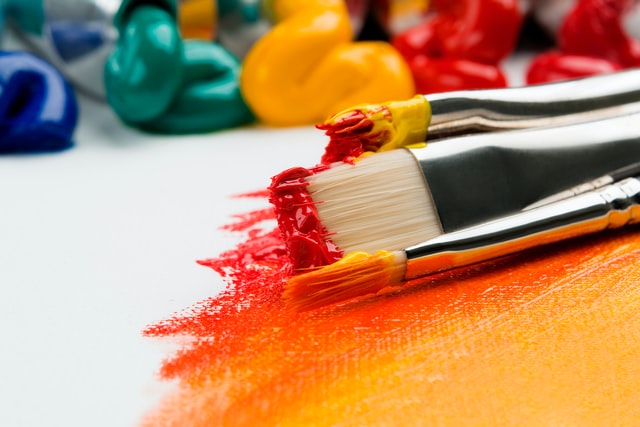
Stay connected.
Sign up to our newsletter for updates on new arrivals and exhibitions





